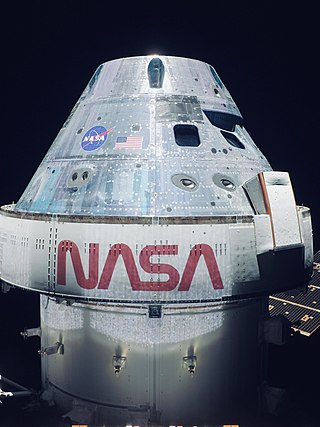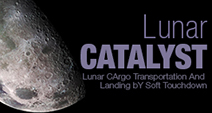Related Research Articles

The Constellation program was a crewed spaceflight program developed by NASA, the space agency of the United States, from 2005 to 2009. The major goals of the program were "completion of the International Space Station" and a "return to the Moon no later than 2020" with a crewed flight to the planet Mars as the ultimate goal. The program's logo reflected the three stages of the program: the Earth (ISS), the Moon, and finally Mars—while the Mars goal also found expression in the name given to the program's booster rockets: Ares. The technological aims of the program included the regaining of significant astronaut experience beyond low Earth orbit and the development of technologies necessary to enable sustained human presence on other planetary bodies.
Lockheed Martin Space is one of the four major business divisions of Lockheed Martin. It has its headquarters in Littleton, Colorado, with additional sites in Valley Forge, Pennsylvania; Sunnyvale, California; Santa Cruz, California; Huntsville, Alabama; and elsewhere in the United States and United Kingdom. The division currently employs about 20,000 people, and its most notable products are commercial and military satellites, space probes, missile defense systems, NASA's Orion spacecraft, and the Space Shuttle external tank.

Masten Space Systems was an aerospace manufacturer startup company in Mojave, California that was developing a line of vertical takeoff, vertical landing (VTVL) rockets, initially for uncrewed research sub-orbital spaceflights and eventually intended to support robotic orbital spaceflight launches.

Astrobotic Technology inc., commonly referred to as Astrobotic is an American private company that is developing space robotics technology for lunar and planetary missions. It was founded in 2007 by Carnegie Mellon professor Red Whittaker and his associates with the goal of winning the Google Lunar X Prize. The company is based in Pittsburgh, Pennsylvania. Their first launch occurred on January 8, 2024, as part of NASA's Commercial Lunar Payload Services (CLPS) program. The launch carried the company's Peregrine lunar lander on board the first flight of the Vulcan Centaur rocket from Florida's Space Force Station LC-41. The mission was unable to reach the Moon for a soft or hard landing. On June 11, 2020, Astrobotic received a second contract for the CLPS program. NASA will pay Astrobotic US$199.5 million to take the VIPER rover to the Moon, targeting a landing in November 2024.
Moon Express is an American privately held early-stage company formed in 2010 by a group of Silicon Valley and space entrepreneurs. It had the goal of winning the $30 million Google Lunar X Prize, and of ultimately mining the Moon for natural resources of economic value. The company was not able to make a launch attempt to reach the Moon by March 31, 2018, the deadline for the prize.

Orion is a partially reusable crewed spacecraft used in NASA's Artemis program. The spacecraft consists of a Crew Module (CM) space capsule designed by Lockheed Martin and the European Service Module (ESM) manufactured by Airbus Defence and Space. Capable of supporting a crew of four beyond low Earth orbit, Orion can last up to 21 days undocked and up to six months docked. It is equipped with solar panels, an automated docking system, and glass cockpit interfaces modeled after those used in the Boeing 787 Dreamliner. A single AJ10 engine provides the spacecraft's primary propulsion, while eight R-4D-11 engines, and six pods of custom reaction control system engines developed by Airbus, provide the spacecraft's secondary propulsion. Orion is intended to launch atop a Space Launch System (SLS) rocket, with a tower Launch escape system.

The Lunar CATALYST initiative is an attempt by NASA to encourage the development of robotic lunar landers that can be integrated with United States commercial launch capabilities to deliver payloads to the lunar surface.

Firefly Aerospace is an American private aerospace firm based in Cedar Park, Texas, that develops launch vehicles for commercial launches to orbit. The company completed its $75 million Series A investment round in May 2021, which was led by DADA Holdings. The current company was formed when the assets of the former company Firefly Space Systems were acquired by EOS Launcher in March 2017, which was then renamed Firefly Aerospace. Firefly's purported purpose is to increase access to space, similar to other private spaceflight companies.

Blue Moon is a family of lunar landers and their associated infrastructure, intended to carry humans and cargo to the Moon, currently under development by a consortium led by Blue Origin and including Lockheed Martin, Draper, Boeing, Astrobotic, and Honeybee Robotics. Two versions of Blue Moon are under development: a robotic lander planned to land on the Moon in 2024, and a larger human lander planned to land a crew of four astronauts on the lunar surface for the NASA Artemis V mission in 2029.

Commercial Lunar Payload Services (CLPS) is a NASA program to hire companies to send small robotic landers and rovers to the Moon's south polar region, mostly with the goals of scouting for lunar resources, testing in situ resource utilization (ISRU) concepts, and performing lunar science to support the Artemis lunar program. CLPS is intended to buy end-to-end payload services between Earth and the lunar surface using fixed-price contracts. The program was extended to add support for large payloads starting after 2025.
ispace Inc. is a public Japanese company developing robotic spacecraft and other technology to compete for both transportation and exploration mission contracts from space agencies and other private industries. ispace's mission is to enable its clients to discover, map, and use natural lunar resources.

Orbit Beyond, Inc., usually stylized as ORBITBeyond, is an aerospace company that builds technologies for lunar exploration. Its products include configurable delivery lunar landers with a payload capacity of up to 300 kg (660 lb), and rovers.

The Intuitive Machines Nova-C, or simply Nova-C, spacecraft are a line of lunar landers designed by the American company Intuitive Machines to deliver small commercial payloads to the surface of the Moon.

Intuitive Machines, Inc. is a publicly-traded American company headquartered in Houston, Texas. It was founded in 2013 by Stephen Altemus, Kam Ghaffarian, and Tim Crain.
McCandless Lunar Lander, also known as the McCandless Lunar Delivery Service, is a concept for a robotic lunar lander proposed as one of the commercial cargo vehicles for NASA's Commercial Lunar Payload Services (CLPS). The lander was proposed to NASA for funding by the aerospace company Lockheed Martin, and it is based on the successful Mars landers Phoenix and InSight.

Beresheet was a demonstrator of a small robotic lunar lander and lunar probe operated by SpaceIL and Israel Aerospace Industries. Its aims included inspiring youth and promoting careers in science, technology, engineering, and mathematics (STEM), and landing its magnetometer, time capsule, and laser retroreflector on the Moon. The lander's gyroscopes failed on 11 April 2019 causing the main engine to shut off, which resulted in the lander crashing on the Moon. Its final resting position is 32.5956°N, 19.3496°E.

The Artemis program is a Moon exploration program that is led by the United States' NASA and was formally established in 2017 via Space Policy Directive 1. The Artemis program is intended to reestablish a human presence on the Moon for the first time since Apollo 17 in 1972. The program's stated long-term goal is to establish a permanent base on the Moon to facilitate human missions to Mars.
Ceres Robotics Inc. is a private, commercial company dedicated to the development and manufacturing of robotic lunar landers and rovers.
Redwire Corporation is an American aerospace manufacturer and space infrastructure technology company headquartered in Jacksonville, Florida. The company was formed on June 1, 2020 by the private equity firm AE Industrial Partners.
References
- ↑ DEEP SPACE SYSTEMS Revenue, Growth & Competitor Profile. Inc Fact Accessed on 13 December 2018
- ↑ Deep Space Systems, Inc. - Company profile. Accessed on 13 December 2018
- 1 2 3 Deep Space Systems. Eric Peterson, Company Week. 11 November 2018
- ↑ https://www.aeroequity.com/redwire/ Redwire
- ↑ "Made in Space acquired by private equity firm". 2020-06-23. Retrieved 2020-06-30.
- ↑ "NASA Announces New Partnerships for Commercial Lunar Payload Delivery Services". NASA. 29 November 2018. Retrieved November 29, 2018.
 This article incorporates text from this source, which is in the public domain .
This article incorporates text from this source, which is in the public domain . - ↑ NASA selects nine companies for commercial lunar lander program. Jeff Foust, Space News. 29 November 2018
- ↑ Draft Concepts for Commercial Lunar Landers. NASA, CLPS. Accessed on 12 December 2018
- ↑ Lunar Resource Prospecting. S. A. Bailey. Abstract presented at the "Lunar ISRU 2019: Developing a New Space Economy Through Lunar Resources and Their Utilization". July 15–17, 2019, Columbia, Maryland